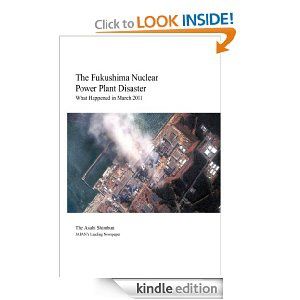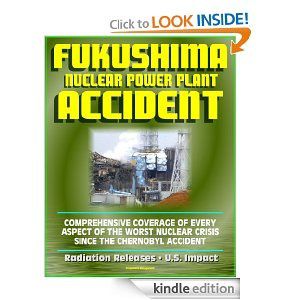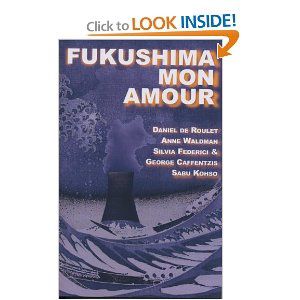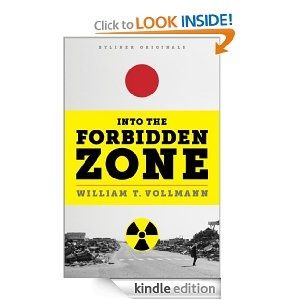
information about Fukushima published in English in Japanese media info publiée en anglais dans la presse japonaise
19 Mai 2012
I “pinched” this idea of making a list of books on Fukushima from Pierre Fetet’s blog.
Those interested in reading books in French can check the following page :
http://fukushima.over-blog.fr/article-des-livres-sur-fukushima-105303511.html
Here is a first list of books in English about the Fukushima disaster. Please let me know of any title I have undoubtedly missed.
Note : I got most of the titles from Amazon.com. I also used the presentations of the books available on the Amazon site. Please understand these do not reflect any personal opinion.

Takashi Hirose wrote this book in a heat of passion mixed with terrible sadness in the weeks following the Fukushima nuclear disaster. But he is far from a newcomer to this field; he has been writing books and articles warning of the terrible dangers of nuclear power since the early 1980s. In this book, which was a best seller in Japan, he not only describes the comic-if-not-so-tragic series of fumbling errors that lead to the meltdown at Fukushima, but also makes clear the absurdity of putting nuclear power plants anywhere on the earthquake and volcano prone Japanese archipelago - and by extension, anywhere in the world. This is the first translation into English of any book by this authoritative critic of nuclear power.

This new book offers detailed analyses of the Fukushima No. 1 nuclear power plant accident that occurred hours after the March 11 Great East Japan Earthquake and tsunami.
"The Fukushima Nuclear Power Plant Disaster: What Happened in March 2011," in three parts, is an attempt to look into what went wrong at the Fukushima nuclear power plant in the accident, now rated a Level 7 major accident, the highest level on the International Nuclear and Radiological Event Scale (INES).
The first section of the book, written by Mariko Takahashi, a senior staff writer of The Asahi Shimbun, follows key developments at the Fukushima plant in chronological order. It examines how the government and Tokyo Electric Power Co. coped with the crisis, including the way they handled the release of information to the press.
The author also looks at how public concern about safety standards on the radioactive contamination of food grew as the nuclear accident unfolded. She observes: "People were not just troubled by the vague worry about contamination exceeding safety limits; they were increasingly distrustful of Japanese safety standards in general."
The second section, written by Toshihiko Katsuda, an Asahi Shimbun science correspondent based in Washington, looks at how the foreign media reported on the Fukushima nuclear crisis. In a nutshell, the author says many articles accused Japan of responding too slowly to the nuclear crisis.
"The point cited included the delay of venting from the primary containment vessel and of injecting the seawater to cool down the reactor vessel," he says.
The last section contains the results of an Asahi Shimbun public survey on the nuclear crisis.
The poll, among other things, shows that while significant segments of the public in China and the United States continue to give robust support to nuclear power, opinion in Japan, South Korea and France appears to have been rocked by the crisis.

Born in Japan and raised in Adelaide and Bangkok, the author Yujiro Taniyama studied economics at Keio University, Tokyo, before starting a career in show business.
Yujiro Taniyama is an acclaimed filmmaker/ author/ TV presenter (BBC, ITV, RTL, TV Tokyo). He was also the youngest candidate running for the position of Governor of Tokyo in the 2011 election, held shortly after the devastating magnitude 9.1 earthquake. In this book, Yujiro Taniyama exposes the Japanese government's failures in the aftermath of the FUKUSHIMA-Tsunami crisis that shook the world on 3/11. Who should be sacked? Why? Is Nuclear-Energy still safe?!
When interviewed by TIME magazine, Yujiro Taniyama said "Japan has been complacent after the bubble economy collapsed in the early 90's. It needs to be shaken up". The author challenges not only the Japanese Establishment, but also exposes the "suspects" whose mistakes led to the catastrophic meltdown of nuclear reactors 1,2,3 & 4 at the Fukushima Daiichi nuclear power plant.
Yujiro Taniyama has spoken to the victims whose lives have been shattered by the blunders of TEPCO, the residents near the Fukushima Daiichi nuclear power plant. He promoted various fundraising efforts and organised volunteers to visit the afflicted citizens of Miyagi and Fukushima prefectures in the Tsunami-hit Tohoku region of Japan. The destruction and suffering of the people lead Yujiro Taniyama to investigate such issues as whether the nuclear crisis could have been avoided and did the Japanese government and TEPCO try to cover-up the full effects of the hydrogen gas explosions and the subsequent leak of radioactive material.
The revelations in this book are likely to frighten the nuclear power industry around the world today. "There is no guarantee that New York won't be the next Fukushima" , mentions Yujiro Taniyama.
This book is a thoughtful analysis of the 21st century's first nuclear disaster.

The three major nuclear power plant accidents - Fukushima Daiichi in 2011, Three Mile Island in 1979, and Chernobyl in 1986 - are fully covered in this authoritative collection of official reports, with over 1,300 pages.
Fukushima Accident: This thorough compilation of official information and documents includes material from International Atomic Energy Agency (IAEA), the Nuclear Regulatory Commission (NRC), U.S. government agencies, and official sources in Japan - providing an authoritative running narrative of the event as it happened hour by hour, plus important and little-known background data. TEPCO's latest roadmap for achieving a cool shutdown of the damaged reactors and dealing with the accident is covered. Expert testimony before the U.S. Senate and material from the NRC discusses the safety of U.S. nuclear facilities in light of the Fukushima accident; there is extensive discussion of the earthquake risk at California power plants, emergency planning for loss of coolant accidents, and preparations for public health impacts. Information from the EPA and FDA deals with the effects of radiation from Fukushima on the environment and food supply of the United States. A unique chapter provides the running account of TEPCO's problems and radiation leaks from the Kashiwazaki-Kariwa Nuclear Power Station in Niigata Prefecture following a strong earthquake in 2007. …..

Comprehensive coverage of the crisis at the Fukushima Daiichi Nuclear Power Station - the world's worst nuclear accident since Chernobyl. Ten chapters and over 1,000 pages cover every aspect of the accident from the moment it began on March 11, 2011 following the Great East Japan Earthquake. This magnitude 9.0 earthquake and the subsequent tsunami caused significant damage to four of the six units of Fukushima Daiichi, operated by the Tokyo Electric Power Company (TEPCO), as the result of a sustained loss of both the offsite and on-site power systems. Efforts to restore power to emergency equipment have been hampered or impeded by damage to the surrounding areas due to the tsunami and earthquake. As the fuel rods became partially uncovered, hydrogen gas built up inside the reactor buildings and caused devastating explosions. Radiation was released, and widespread evacuations were ordered.
This thorough compilation of official information and documents includes material from International Atomic Energy Agency (IAEA), the Nuclear Regulatory Commission (NRC), U.S. government agencies, and official sources in Japan - providing an authoritative running narrative of the event as it happened hour by hour, plus important and little-known background data. TEPCO's latest roadmap for achieving a cool shutdown of the damaged reactors and dealing with the accident is covered. Expert testimony before the U.S. Senate and material from the NRC discusses the safety of U.S. nuclear facilities in light of the Fukushima accident; there is extensive discussion of the earthquake risk at California power plants, emergency planning for loss of coolant accidents, and preparations for public health impacts. Information from the EPA and FDA deals with the effects of radiation from Fukushima on the environment and food supply of the United States. A unique chapter provides the running account of TEPCO's problems and radiation leaks from the Kashiwazaki-Kariwa Nuclear Power Station in Niigata Prefecture following a strong earthquake in 2007.
Contents: Chapter 1: Roadmap towards Restoration from the Accident at Fukushima Daiichi Nuclear Power Station; Chapter 2: International Atomic Energy Agency (IAEA) Statements on the Fukushima Nuclear Accident Through mid-April; Chapter 3: Japan Government Statements and Notices About the Fukushima Nuclear Crisis - including News Briefings by Nuclear and Industrial Safety Agency (NISA), Chief Cabinet Secretary Edano, and Prime Minister Kan; Chapter 4: CRS Report for Congress - Fukushima Nuclear Crisis; Chapter 5: Nuclear Regulatory Commission Material; Chapter 6: American Government Agencies; Chapter 7: Energy Department Material; Chapter 8: Testimony before the U.S. Senate; Chapter 9: Tokyo Electric Power Company (TEPCO) Press Releases Regarding the Kashiwazaki-Kariwa Nuclear Power Station after the Niigata-Chuetsu-Oki Earthquake (2007 Incident and Response).
This is a privately authored news service and educational publication of Progressive Management.

Fukushima mon amour (Tu n’as rien vu à Fukushima) is a personal letter to a
Japanese friend, in memory of an evening spent in Tokyo, one year to the day
before the tsunami and the nuclear catastrophe of Fukushima. This letter
equally evokes other misfortunes that have befallen Japan, as well as the
pleasant memory of a voyage on the beach of Sendai – proof of an
extraordinary fascination for the uneasy elegance of this refined culture.
This work also discusses the relationship between nucleocrats and the world
of literature, as well as explores a number of areas of contention between
Europe and Japan. The author, having worked himself in a nuclear power
plant, writes these pages with a benevolent lucidity – like an echo of Hiroshima
mon amour – in which the heroine hears a reverberation of her own reproach:
You saw nothing at Hiroshima.
(Editor’s Notes) http://www.unexcursus.fr/Presse/DaUk%20fukushima-un%20excursus.pdf

Just weeks after multiple disasters struck Japan, National Book Award winner William T. Vollmann ventures into the nuclear hot zone, outfitted only with rubber kitchen gloves, a cloth facemask, and a capricious radiation detector. He emerges with a haunting report on daily life in a now-ravaged Japan -- a country he has known and loved for many years. And in the cities and towns hit hardest by the earthquake, tsunami, and radioactive contamination, Vollmann finds troubling omens of a future heading toward us all.